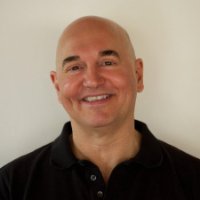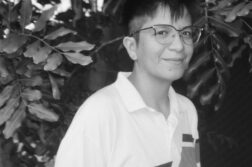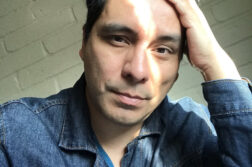 FOR MORE THAN THREE DECADES, John Manuel-Andriote has been a critical voice on hiv-aids in such periodicals as The Advocate and The Washington Post. In 1999, he published Victory Deferred: How AIDS Changed Gay Life in America, his landmark book on the LGBT community’s transformation from disenfranchised isolation into a self-affirming political and social force even while grappling with illness, death, and bigotry.
FOR MORE THAN THREE DECADES, John Manuel-Andriote has been a critical voice on hiv-aids in such periodicals as The Advocate and The Washington Post. In 1999, he published Victory Deferred: How AIDS Changed Gay Life in America, his landmark book on the LGBT community’s transformation from disenfranchised isolation into a self-affirming political and social force even while grappling with illness, death, and bigotry.
His latest book, Stonewall Strong, is a hybrid memoir and historical narrative chronicling his own and the LGBT community’s struggles with trauma and resiliency. Andriote colorfully illuminates pivotal periods in LGBT history, from the Mattachine Society’s striving for assimilation in the 1950s to Gay Liberation in the ’70s, the devastation of AIDS in the following decade, and the struggle for marriage equality in recent decades. The experiences of some of the men and women in these movements exemplify the spirit of resiliency that Andriote wants to document. Framing the historical sections are Andriote’s personal reflections, analyses of research, and interviews with LGBT people who have overcome the effects of childhood abuse, stigma, addiction, depression, and suicide as they move toward self-acceptance, building supportive communities, and achieving wholeness through resiliency.
Andriote contributed a piece based on his book to the March-April 2017 issue of this magazine. The following interview was conducted via email last November.
— John R. Killacky
John Killacky: First off, thank you for your gloriously perceptive new book. Given its central theme of resiliency in gay men, I wonder how you came to this thesis.
John-Manuel Andriote: I began to think about resilience after I briefly saw a psychiatrist in Washington, in the spring of 2006, as I tried to figure out why I was crying all the time after my October 27, 2005 HIV diagnosis. He told me that it was natural to cry in the face of suffering, and that I was suffering because my diagnosis had completely turned my life upside down, my sense of who I am, my future, my sexuality, my place in the world. It was a new concept for me to consider my own suffering as worthy of my tears as I was used to putting aside my own feelings and needs to take care of others, just as I had been trained to do as the eldest and only son in my family. The doctor also told me I was very resilient, and didn’t need medication or anything else for depression because I would eventually work through this latest trauma as I had done so many earlier traumas in my life.
Thinking about my own resilience got me interested in the subject of resilience. As a health reporter, I’ve long been interested in mental health in particular. I spent many years in therapy and Al-Anon programs working to understand how my life’s traumas had shaped me, even undermined me at times. As I read and wrote about resilience for The Atlantic and Huffpost, I realized that what I had learned on the subject would be of benefit to others, particularly other gay men. I discovered in my research and interviews that most gay men are astonishingly resilient considering the bullying, rejection, and other traumas they experience. I wanted to “bottle up” what I was learning and share it with others who could apply it in their own lives to help themselves work through challenging experiences.
JK: In the book, you write, “Fighting the stigma inside ourselves, self-stigma, is the challenge facing every gay man.” Talk about this a bit more please.
J-MA: In a letter that I reference in Stonewall Strong from Jack Nichols, who with Frank Kameny in 1961 co-founded the Mattachine Society of Washington, D.C., to The Gay Metropolis author Charles Kaiser, Nichols says how strongly touched he was by a citation in the 1951 book The Homosexual in America from the prominent African American activist and author W. E. B. Du Bois: “The worst effect of slavery was to make the Negroes doubt themselves and share in the general contempt for black folk.” Nichols understood the harmful effects of self-stigma in gay men’s lives. When we let our bullies, detractors, and haters define us, and internalize their warped definitions of who we are and what our being gay “means” (always something bad), we become our own worst enemy. We become powerful when we reject their definitions of us and instead choose to define ourselves. We have a whole new, positive experience of being gay when we seize control of the story about us that we tell ourselves in our own hearts and minds, and make ourselves the story’s hero rather than its victim.
JK: In researching this book, you interviewed nearly one hundred queer luminaries including Larry Kramer, Peter Staley, Sean Strub, Evan Wolfson, and Barney Frank. Do tell, who were the most fun, the most difficult?
J-MA: None of the people I interviewed for the book were difficult per se, though I did have some difficulty simply in scheduling interviews with men and women who are as you would expect busy. What I found in talking with people about this very personal subject is that our conversation for many of them was the first time they had reflected on, and articulated, their own resilience. The interviews felt very intimate to me, and offered insights into the private interior lives of some very public figures, such as Barney Frank, Bishop Gene Robinson, the Episcopal Church’s first openly gay bishop, and now-retired U.S. Ambassador Michael Guest, the first openly gay man confirmed as ambassador by the U.S. Senate, and appointed by George W. Bush.
Larry Kramer has a reputation for being “difficult,” but in the three interviews I have done with him over the last twenty years, I have always found him to be a very gentle and tender man. Part of my approach in interviewing public figures like Larry is to find the thing that makes them tick, the thing that drives their work and makes them famous. In Larry’s case, I recognized pretty fast that his public anger was driven by the deep pain of seeing his friends die from AIDS in the earliest years of the epidemic, when the government didn’t seem to care and even many gay men didn’t want to be too close to the “gay plague” because of the stigma attached to HIV from the beginning. So, I always focused on the man I saw within Larry, and I was deeply touched by our interviews.
I describe in the book how Peter Staley, one of ACT UP/New York’s key members in the group’s hay day, was interviewed by a TV station that broadcast his image with the caption “Peter Staley, AIDS victim.” My take was that “next to Larry Kramer, there is probably no one who is less a ‘victim’ than Peter Staley.” I celebrate Peter, and the other men in the book, as a hero because he stepped up from his life as a bond trader on Wall Street to join the community’s efforts to raise awareness and demand attention from the federal government that seemed bent on ignoring AIDS, particularly gay men with the illness, as long as possible.
Evan Wolfson was fascinating to interview, not only because he is a legendary activist who single-mindedly for three decades pushed for legal same-sex marriage because of his deep sense of justice and belief in America’s promise of equal justice for all. Like the other men I interviewed, Evan responded with real loving concern for younger gay men when I asked him what he would say to a young gay boy about the historic events he has shaped and witnessed. “You are part of a community,” he said he’d tell the boy, “that has offered the most resonant, inspiring movement in decades. You are part of the community that has helped America to become a more perfect union that has offered the most inspiring example of belief in what America stands for at its best.”
JK: I particularly appreciated your opening chapters recalling experience from your own life that challenged you to find your own resiliency. As an esteemed journalist, was it difficult to delve into in the first person singular so deeply?
J-MA: Before my 2006 HIV coming-out story for the Washington Post, I had never written for publication about my own experience. Reporters have a knack for expressing ourselves and our views vicariously through those we quote in our stories. Stepping out of the role of writer—or should I say out from behind the mask of the journalist—was a challenge. My editor at the Washington Post, Zofia Smardz, had to keep after me to write more personally, rather than continue to speak with the journalist’s detachment, when I was describing my own pain and suffering. I was brought up by my mother to suck it up, stuff down my fear and sadness, my human need for love, to be strong for others. Learning to write about my own experiences, especially the traumatic ones I describe in part one of Stonewall Strong, was challenging. I certainly cried a lot as I recalled my life’s traumas described in my own contemporaneous accounts of these experiences in my journals. But I persisted because what I learned from that 2006 HIV coming-out story is that my readers frequently tell me about finding their own experiences affirmed, and gaining new insight into themselves, by reading my account. Writing Stonewall Strong has been deeply healing for me personally as I have revisited these difficult times of my life and taken the opportunity, in writing about them, to connect dots and trace the timeline of my own resilience and growth across my life.
JK: Interviews and research from your earlier book, Victory Deferred, are in a collection at the Smithsonian National Museum of American History. How did this come about?
J-MA: In 2008, the museum’s board voted unanimously to accept my donation of all my Victory Deferred research materials—including hundreds of recorded interviews, reporting notes, articles I gathered for years during the early years of the epidemic when I began reporting on it, and correspondence between myself and some noted gay activists such as the late Eric Rofes and Gay Men’s Health Crisis (GMHC) co-founder Dr. Larry Mass. There is also correspondence between myself and Doug Mitchell, my editor at the University of Chicago Press who is widely credited with having launched the academic publishing field of gay (or as it’s commonly called today, queer) studies. I approached the museum about the collection after discussing my options with historian John D’Emilio, a friend whom I also interviewed for Stonewall Strong and who shared interesting observations on teaching and passing on gay history to younger generations. I joke that I simply wanted to clear out all the boxes from the floor of my closet, which is true. But more importantly, I recognized the value of the materials for future historians and journalists. In fact, the National Museum of American History has used a number of materials from the “Victory Deferred” collection in exhibits they put together in 2011, to mark the 30th anniversary of the first reported AIDS cases, and again in 2012 when they reprised the exhibit during the 19th international AIDS conference, held that year in Washington, D.C. It’s an interesting experience—actually odd and kind of creepy—to see your own notes, a photograph of you, and your book in museum showcases in Washington, D.C. I felt enormously gratified and proud that I have used my time and talent to help document important events and people in recent history. I also like to joke that you know you’re getting old when your work is in a museum. That said, I recognize the tremendous honor and privilege given to me and I am grateful for it.
JK: Over the years, you have been such a lucid and articulate queer voice covering the AIDS pandemic. Now that it is considered a chronic manageable disease, are we post-AIDS?
J-MA: The late San Francisco-based activist Eric Rofes in the late 1990s was already writing about needing to “revive the tribe” in a post-AIDS era. By that he meant that even by then, many gay men were finding it impossible to sustain the level of rage that had fueled our angry protests, and the level of hyper-vigilance that had affected our sexual interactions with other men. I quote Eric in the chapter called “To Our Health!”, which focuses on building upon gay men’s resilience as the key to supporting our good health. He championed a holistic approach to gay men’s health that included, but wasn’t so exclusively focused on, HIV as a part—but only a part—of sexual health. Eric believed, as I do and as new research bears out—such as that of Perry Halkitis, formerly at NYU and now at Rutgers—that if you build up gay men’s mental health and sense of well-being, healthy sexual and drug-use choices will follow. We don’t respond well to scolding, never have, but we do tend to rise to meet the higher expectations of people who believe in us and urge us to be our best.
JK: I haven’t read your Hot Stuff: A Brief History of Dance/Disco Music, but I love your children’s book with illustrator Katie Runde, Wilhelmina Goes Wandering about the escaping cow. Your writing is prolific and topics expansive. So, what’s next for you?
J-MA: As a journalist, I connect dots and draw connections that others don’t necessarily see at first. When people asked, teasingly and in puzzlement, as to why I followed up a “serious” book like Victory Deferred in 1999 with a “fluffy” book in 2001 about disco music, I got them thinking twice. I explained that when you examine disco music in the context of the 1970s—with its gas lines, Watergate, the ending of the Vietnam war, high inflation called “stagflation—it’s clear that the music became wildly popular because it provided a happy escape from the traumatic times we were living in. Disco music taught us to celebrate life’s good times even in our hard times. I think that’s a big reason so many gay men love and listen to dance music. It really is motivating and fun.
Of the books I’ve written, Wilhelmina Goes Wandering is the one I love the best. I reimagined the true story of a runaway cow in Connecticut, where I grew up and returned in 2007 after 30 years “away,” as the story of someone (in this case, a black Angus cow) who runs away from her familiar pasture to find her true home. She finds it among the deer who became—in the real-life story—her traveling companions, and in the character of Betty, the gentle Scottish lady farmer who adopts Wilhelmina once she is captured and relocated to an animal sanctuary. The reason I love this story—I call it a “fable for kids ages 5 to 105” because I have had such positive responses to it from people of all ages—is that it is my own story and that of many, many others who likewise have found they must leave everyone and everything familiar that stands in the way of being the person they know themselves inside to be. Certainly, many gay men know this experience, though it is not a uniquely “gay” experience—but rather a human one.
Before another book project, my first goal is to find one or more corporate marketing partner who will support my efforts to take the inspiring message of Stonewall Strong across the country. This fall I started writing a blog for Psychology Today, also called “Stonewall Strong,” in which I am showcasing concepts and insights I gathered in the book. I really enjoy sharing with audiences what I know when it can benefit them in their own lives.
As for a next book, I have already shared with my editor at Rowman & Littlefield my interest in reviving a book proposal I developed but put aside in the early 2000s, focused on aging. I don’t know whether it will focus only on gay people, though what we know about aging well—actually a lot—will certainly be included in it. I mainly want to explore how, as with writing in Stonewall Strong about resilience, aging well is largely about framing our stories of aging in positive terms rather than the more typical negative ones all around us in our ageist culture and gay subculture. My working title on the original proposal was “Halcyon Days” after Walt Whitman’s poem of that name, in which he celebrates an old age as life’s very quintessence. He uses the image of a ripe apple to say that the older years are the rich time of harvest as we savor the sweetness that has remained after life has tested and tried us—and delivered us, hopefully safely and intact, to this next season of our lives.
 Stonewall Strong
Stonewall Strong
by John-Manuel Andriote
Rowman & Littlefield. 313 pages, $35.98
John R. Killacky is executive director of Flynn Center for the Performing Arts, Burlington, VT.





